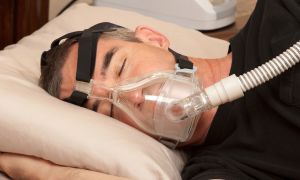Typically, people who tend to be overweight or obese, or have a very large neck size, are more prone to sleep apnea. However, this is not always the case. The only true way to be able to tell if someone has sleep apnea is to undergo a test called polysomnography, or a sleep study. This is performed overnight at a medical facility, with continuous monitoring, while the person is observed during sleep.
Although your partner's snoring might make you want to stuff socks down his throat, instead look for signs of sleep apnea. The most critical indicator is a pause in breathing for more than 10 seconds. But be careful -- breathing can be an illusion.
You may look over at Mr. Lawn-Mower Mouth, see his belly moving up and down, and assume he is breathing; but that might just be his diaphragm trying to pull air down. His gut can be moving, even if he's not inhaling.
So don't just look; listen for changes in breath. Snoring is actually a good thing. (Never thought you'd hear that, huh?) It signals that some air is actually moving in and out. No snoring, after a period of snoring, can be a warning that no air is moving in and out. If there's no sound for 10 or more seconds, and there isn't a whoosh of air out of the nose or mouth, it's a sign that breathing has stopped.
You also can check yourself if you live alone. If you're constantly so tired that you can fall asleep anywhere during the day, it could be a sign of apnea. Another clue is neck size. If it's over 17 inches, you have more than a 50% chance of developing sleep apnea.
Continue Learning about Sleep Apnea
Important: This content reflects information from various individuals and organizations and may offer alternative or opposing points of view. It should not be used for medical advice, diagnosis or treatment. As always, you should consult with your healthcare provider about your specific health needs.



